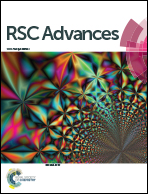Single and repeated dose toxicity of citric acid-based carbon dots and a derivative in mice†
Abstract
Carbon dots (CDs) have recently emerged as a new class of fluorescent nanomaterials and are already competitive in many respects to conventional semiconductor quantum dots (QDs). Despite CDs remarkable advantages in bioimaging, biosensing and other biomedical applications, their biosafety is still unclear. In the present study, the systematic single and repeated dose toxicity and biodistribution of two citric acid-based probes (CDs and a derivative, Et-IPCA) were investigated in vivo. For the single dose toxicity studies, the lethal dose 50 (LD50) of CDs was 391.615 mg kg−1 and 357.771 mg kg−1 for female and male mice, respectively, while Et-IPCA reached its saturation point in solution at 25 mg kg−1 and did not lead to the death of any mice at that concentration. For the repeated dose toxicity studies, although there were temporary changes in hematological parameters suggesting an acute inflammatory response after seven doses, the data on the body weight, organ coefficients, hematological parameters, blood biochemistry, and organ histopathology at the end of the 90 day recovery period suggested that both the CDs and Et-IPCA had low toxicity over the 90 day period. These findings will be useful for the future development of CDs-based drug delivery systems and for the development of clinical applications of these systems.


 Please wait while we load your content...
Please wait while we load your content...